FINDING THE MEAN MEDIAN AND MODE FROM A FREQUENCY TABLE
Subscribe to our ▶️ YouTube channel 🔴 for the latest videos, updates, and tips.
When the same data appears several times we often summaries it in a frequency tables. For convenience we denote the data values by x and the frequencies of these values of f.
Finding mean :
Mean = the sum of all values / the number of data values
Finding median :
N is the total number of frequency.
When number of terms is odd,
median = (N+1)/2th term
When number of terms is even,
median = (N/2)th term and (N/2)+1th term
Mode :
The data which has most frequency is mode of the data set.
Problem 1 :
Each student in a class of 20 students is assigned a number between 1 and 10 to indicate his or her fitness.
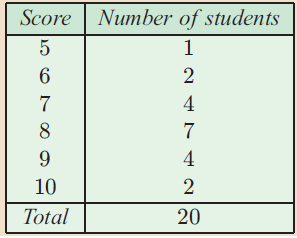
Calculate the
a) mean b) Median c) Mode d) Range
Solution :
a) Mean :
Mean = Sum of all values / Total number of values
= [5(1) + 6(2) + 7(4) + 8(7) + 9(4) + 10(2)] / 20
= (5 + 12 + 28 + 56 + 36 + 20)/20
= 157/20
= 7.85
So, the required mean is 7.85.
b) Median :
N = 20 (even)
Average of N/2 th element + (N/2) + 1 th element = median
= 10th + 11th elements
|
Score 5 6 7 8 9 10 |
Frequency 1 2 4 7 4 2 |
Cumulative Frequency 1 1+2 ==> 3 3+4 ==> 7 7+7 ==> 14 14+4 ==> 18 18+2 ==> 20 |
10th and 11th elements are 8.
Median = (8 + 8)/2
= 8
c) Mode :
The highest frequency is 7, its corresponding score is 8. So, mode = 8.
Range :
Least score = 5, highest score = 10
Range = 10 - 5
= 5
Problem 2 :
The members of a school band were each asked how many musical instruments they played. The results were
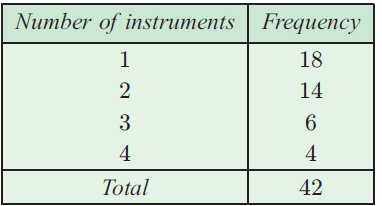
Calculate the
a) mean b) Median c) Mode d) Range
Solution :
a) Mean :
Mean = Sum of all values / Total number of values
= [1(18) + 2(14) + 3(6) + 4(4)] / 42
= (18 + 28 + 18 + 16) / 42
= 80/42
= 1.90
b) Median :
N = 42 (even)
Average of N/2 th element + (N/2) + 1 th element = median
= 21th + 22th elements
= (2+2)/2
= 2 is the median
c) Mode :
The highest frequency is 1, its corresponding score is 18. So, mode = 18.
Range :
Least number of instruments = 1, highest number of instruments = 4
Range = 4 - 1
= 3
Problem 3 :
The following frequency table records the number of books read in the last year by 50 fifteen years old.
a) For this data, find the
a) mean b) Median c) Mode d) Range
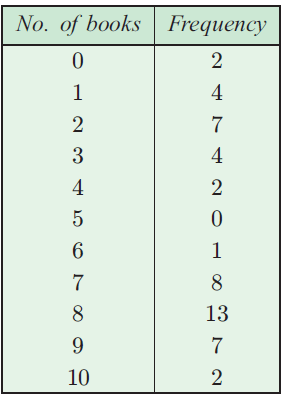
b) Construct a vertical bar chart for the data and show the position of the measures of center on the horizontal axis.
c) Describe the distribution of the data
d) Why is the mean smaller than the median for this data ?
e) Which measure of center would be most suitable for this data set ?
Solution :
a) mean
= (0 + 4 + 14 + 12 + 8 + 0 + 6 + 56 + 104 + 63 + 20) / 50
= 287/50
= 5.74
b) Median :
Total number of terms (N) = 50
Median = (25th + 26th) terms / 2
By creating frequency table, we get these elements simply.
|
No of Books 0 1 2 3 4 5 6 7 8 9 10 |
Frequency 2 4 7 4 2 0 1 8 13 7 2 |
Cumulative frequency 2 6 13 17 19 19 20 28 41 48 50 |
25th element = 7, 26th element = 7
= (7 + 7)/2
= 7 is the median
c) Mode :
The highest frequency is 13, so mode is 8.
d) Range :
= 10 - 0
= 10
b) Constructing vertical bar :
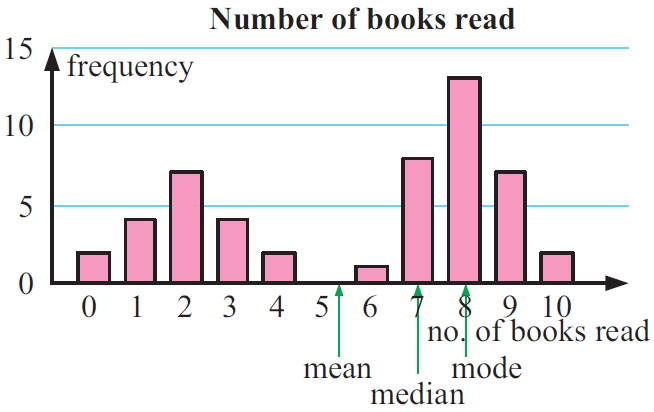
d) The mean takes into account the full range of numbers of books read and is affected by extreme values. Also the values which are lower than the median are well below it.
e) Median.
Problem 4 :
Hui breeds ducks. The number of ducking survying for each pair after one month is recorded in the table,
a) Calculate the
i) Mean ii) Median iii) Mode iv) Range
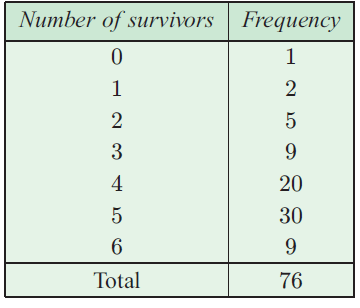
b) Is the data skewed
c) How does the skewness of the data affect the measures of the middle of the distribution?
Solution :
a) i) Mean
= [0(1) + 1(2) + 2(5) + 3(9) + 4(20) + 5(30) + 6(9)]/76
= (0 + 2 + 10 + 27 + 80 + 150 + 54)/76
= 323/76
= 4.25
ii) Median
N = 76, N/2 ==> 38
|
Survivors 0 1 2 3 4 5 6 |
Frequency 1 2 5 9 20 30 9 |
Cumulative frequency 1 3 8 17 37 57 66 |
Median = (5 + 5)/2
= 5
iii) Mode = 5 is repeating 30 times. So, mode = 5
iv) Range :
= 6 - 0
= 6
b) The mean is negatively skewed
c) The mean is less than the mode and median.
Subscribe to our ▶️ YouTube channel 🔴 for the latest videos, updates, and tips.
Recent Articles
-
Finding Range of Values Inequality Problems
May 21, 24 08:51 PM
Finding Range of Values Inequality Problems -
Solving Two Step Inequality Word Problems
May 21, 24 08:51 AM
Solving Two Step Inequality Word Problems -
Exponential Function Context and Data Modeling
May 20, 24 10:45 PM
Exponential Function Context and Data Modeling